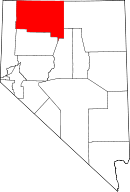Hardin City, Nevada
| Hardin City | |
| Ghost town | |
| Name origin: Named after James Allen Hardin | |
| Country | United States |
|---|---|
| State | Nevada |
| County | Humboldt |
| Elevation | 3,980 ft (1,213 m) [1] |
| Coordinates | 41°06′53″N 119°00′09″W / 41.11472°N 119.00250°WCoordinates: 41°06′53″N 119°00′09″W / 41.11472°N 119.00250°W [1] |
| Timezone | Pacific (PST) (UTC-8) |
| - summer (DST) | PDT (UTC-7) |
|
Location of Hardin City in Nevada | |
Hardin City, Nevada was the site of a silver mining boom town from 1859 until about 1868. Hardin City was located on the western slope of the Black Rock Range in the Black Rock Desert.[1]
Timeline
In 1849, James Allen Hardin traveled the Applegate-Lassen Trail. While north of the Black Rock, he found ore that at the time he thought was lead. He returned to camp with thirty or forty pounds and found that it easily melted. They made bullets out of a portion, left a portion at the camp and kept a portion. The portion that remained at camp was later found and eventually assayed to be a carbonate of lead and silver.[2] Hardin smelted a portion of the rock down to a button that many[3] thought to be sliver. Hardin sent the button to San Francisco in 1850, where it was lost in the fire of 1850[3] (possibly the San Francisco Fire of 1851?). In the meantime, Hardin had settled in Petaluma, California. In 1858, an expedition was launched to find the mine. As with many stories of a lost mine, nothing was found, though there was a rush and the town of Hardin City was created.[2]
On April 26, 1859 Peter Lassen and Edward Clapper were killed nearby at what was later called Clapper Creek[4] while searching for silver first reported by Hardin.[2][5]
In May 1860, news of the First Battle of Pyramid Lake caused the prospectors to leave the area.[3]
In 1866, prospectors returned to the area and a post office was in operation as Harden City from July 1866 until October 1866 and then as Harveyville from October 1866 until August 1867.[6] During that time, ore from the area was refined, but silver could not be reliably recovered. Fairfield wrote that the mills were processing ore from the Comstock Lode, which was being released by the alkali dust in the Black Rock ore. This would account for the fact that the first run of Black Rock ore would result in high values, but later runs would have low values.[2]
The Hardin City area never produced significant quantities of silver, though Ladue Vary came to Hardin City to prospect and in 1884 found silver and gold to the northeast.[2]
Vanderburg states that Hardin's silver was probably from the Silver Camel mine near Sulphur, Nevada. The Silver Camel Mine has Cerargyrite also known as Chlorargyrite or horn silver. Cerargyite is silver chloride (AgCl), which does not match the carbonate of silver and lead as reported by Fairfield above.[7]
References
- 1 2 3 "Hardin City (Locale)". Geographic Names Information System. United States Geological Survey. 1 Feb 1990. Retrieved 20 Dec 2015.
- 1 2 3 4 5 Fairfield, Asa Merrill (1916). Fairfield's Pioneer History of Lassen County, California. H. S. Crocker. p. 419. Retrieved 2015-12-20.
- 1 2 3 Angel,, Myron; Myrick, David F. (1958). Reproduction of Thompson and West's History of Nevada, 1881. Retrieved 2015-12-20.
- ↑ "Clapper Creek". Geographic Names Information System. United States Geological Survey. 1980-12-10. Retrieved 2015-12-21.
- ↑ "Skeleton May Be Lassen's Partner". Santa Cruz Sentinel. February 17, 1992. p. 10. Retrieved December 21, 2015 – via Newspapers.com.

- ↑ "Harveyville Post Office (historical)". Geographic Names Information System. United States Geological Survey. 1990-02-01. Retrieved 2015-12-20.
- ↑ Vanderburg, W. O. (1938). Reconnaissance of mining districts in Humboldt county, Nevada (Report). U. S. Bureau of Mines. p. 9. Retrieved 2015-12-20.
Further reading
- "The Black Rock Silver Mines," San Francisco Alta, Vol XVII, No. 6022, Tuesday Morning, Sept. 6, 1866.
- Idah Meacham Strobridge, "In Miner's Mirage-Land," p. 70, Chapter "The rise and fall of Hardin City," 1904, Full text available from archive.org.
- Nell Murbarger, "Lost Hardin Silver, Mystery or Hoax?," pp. 9–12, Desert Magazine, April 1955.
- Sessions S. Wheeler, "The Black Rock Desert," p. 137, 1978.
